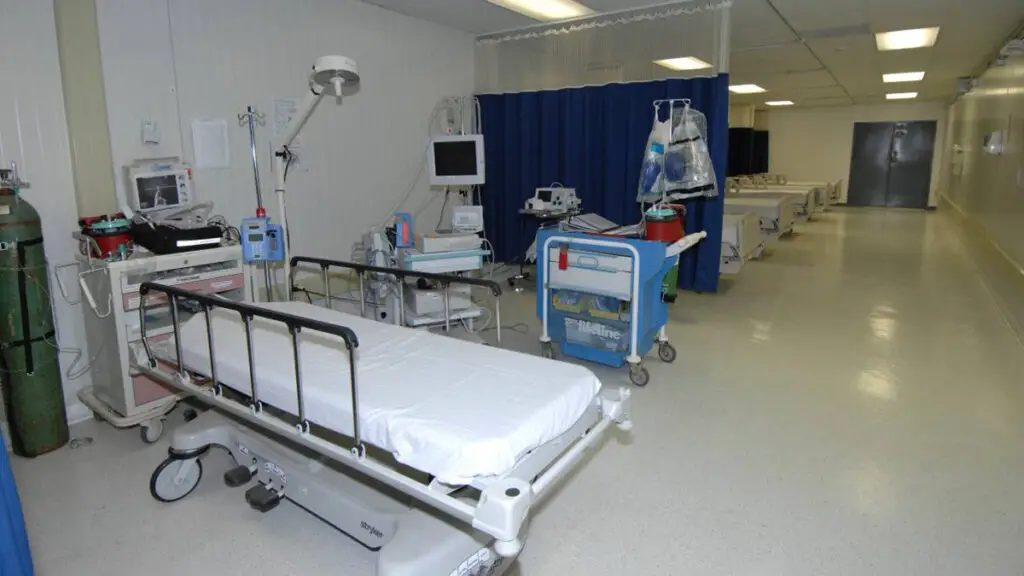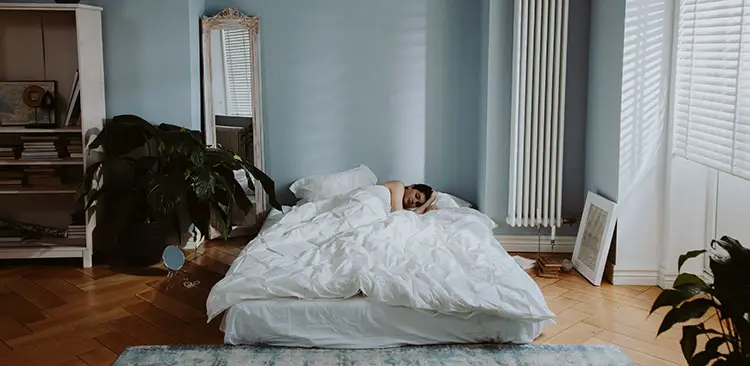
If you’re looking for the means to keep yourself or someone else in bed at night without falling onto the floor, or you need some level of assistance with getting into and out of their bed, bed rails as a solution.
The only problem is that a bed rail can be dangerous.
Why Bed Rails Can Be Dangerous
The Food and Drug Administration (FDA) and the Consumer Product Safety Commission (CPSC) seem to think bed rails are dangerous. In fact, they they’ve released several statements on how they believe bed rails both should and should not be used.
The problem comes from the gap between the bed rails and the mattress.
This gap in turn serves as a cavity for someone to fall into and be unable to extricate themselves from. Most of the time, a bed rail is used for somebody who suffers from severe sarcopenia, paralysis, a high level of pain, dementia, or from some other medical condition which necessitates their having an aid to both get into and out of bed.
It’s because of this that people who become trapped within the space between a mattress and a bed rail may not be able to get out. The result can be serious injury – even to the point of death.
Over the course of 11 years, the CPSC kept track of how many deaths and injuries occurred due to bed rails (from January 2003 to September 2012) and found that there was a total of 155 deaths and 5 injuries due to bed rails.
Of those 155 deaths
- 143 were due to entrapment, and
- 12 were due to falls.
That means 92% of those deaths were due to the victim becoming trapped by the bed rail. Virtually all of these deaths were caused by injuries to the neck and head, 83% of deaths happened to those 60+ years old, and roughly 50% of these deaths were with those who already had a diagnosed medical condition such as Alzheimer’s, cardiovascular disease, cerebral palsy, dementia, heavy medications, mobility issues, or seizures.
About 60% of these deaths occurred at peoples’ homes while the remainder took place amongst nursing homes, hospice care, or assisted living facilities.
Falls occurred when the victim fell off the bed rail, climbed over the bed rail, fell and hit the bed rail or fell due to an unraised bed rail. All fall events resulted in death.
If you look even further back into history, you can find that from 1985 to 2013 the FDA received reports of a total of 901 instances of entanglement due to bed rails. Apparently, not all of the actual incidents get reported to the FDA as another organization, the NEISS, reported that from January 2003 to December 2011 there were 36,900 bed rail-related injuries within the US that required the patient receiving care at an emergency room.
To perhaps help to keep things in perspective though, there are currently roughly 2.5 million hospital/nursing home beds within the United States.
Even if all those 36,900 events took place within the span of a single year, we’re talking about a little over 1% of the people who would use a bed rail being injured. We’re not talking about that many events in a single year though even if the NEISS statistics are underreported. This isn’t to say there isn’t some level of inherent risk associated with bed rails, however.
One of those inherent risks is the potential to end up in legal trouble due to “restraining” somebody against their will.
Why Bed Rails Can Be Considered a Restraint
Hospital and nursing home settings must be very careful that they do not inadvertently use physical or chemical restraints. Bed rails can be considered a form of restraint as the person in the bed may be physically unable to remove the bed rail and thus be trapped in the bed.
According to The Joint Commission, the intent behind why one is using bed rails matters. If the bed rails are intended to keep somebody in bed, then the bed rails would then be considered a form of restraint.
If the intention isn’t to keep somebody in bed, but instead to keep somebody from falling, then the bed rails are not considered a restraint.
If the individual can’t get out of a bed by themselves even if bed rails aren’t present, then the presence of bed rails isn’t considered a form of restraint. And yes, just in case you were wondering, if you are using a net/enclosure bed, that would classify as a form of restraint.
Others have pointed out that if the individual in the bed cannot voluntarily remove the bed rails, then the bed rails would then be considered a form of restraint as well.
Are there ways that we can avoid these potential legal pitfalls altogether while simultaneously ensuring that somebody is both protected from falls and able to get up and out of bed?
Yes, by using alternatives.
9 Alternatives to Bed Rails
Fortunately, bed rails aren’t the only solution to the problem at hand. There are a number of other options available on the market one may want to consider instead.
1 – A Ceiling Trapeze
This is an alternative option if the point of using a bed rail is to help the person ambulate into and out of the bed.
You may have seen these in hospital rooms before. This is simply a trapeze that hangs from the ceiling over the person’s bed. There’s minimal risk of getting entangled in anything, tripping over anything, or hitting one’s head against any form of rail.
- VERSATILE FUNCTIONALITY: This trapeze bar for beds and handle offer dual usability – easily secure them to various bed frames, including hospital style beds and adjustable beds, or utilize them with an Invacare floor stand (part #7714P; available separately).
- USER-FRIENDLY DESIGN: The three-sided handle provides multiple grab points, while a horizontal bar enhances gripping options, ensuring easy and adaptable use for bed mobility.
Simply grab onto the trapeze, and position oneself as is best. The catch here is that a trapeze hanging from the middle of the ceiling isn’t the best feng shui – being something of an eye sore, but it is an option.
2 – Bed Alarms
This is more for the benefit of nearby family members than it is for anything else. Bed alarms are pads which are placed under the sheets of a bed which monitor pressure. Should the bed alarm detect that all pressure on it has disappeared or is spread strangely, the alarm will go off.
- THE SAFEST BED ALARM SYSTEM FOR CAREGIVERS - A caregiver should always be notified as soon as an elderly loved one gets up from bed. The Smart Caregiver Wireless Bed Alarm System is the most-effective emergency alert system for the elderly, or disabled. The perfect hospital bed pad for elderly monitoring. Our bedside device allows caregivers to rest peacefully, knowing they will be alerted in time if their elderly patient gets out of bed.
- 25 YEARS OF RELIABILITY - For the past 25 years, Smart Caregiver bed alarms for elderly monitoring are used by over 2,800,000 Caregivers around the world, nearly 40,000 products being used as home alerts for elderly, throughout upwards of 10,000 caregiver facilities around the world! Unlike our competitors, the Smart Caregiver wireless bed alarm system is the ONLY elderly fall prevention device that can detect bedside movement from up to 300 feet away, providing safety for an elderly patient anytime, anywhere.
Family throughout the house are then alerted as to what’s going on, and should the patient be trapped by bed rails, the family can quickly intervene to ensure no permanent damage or injury takes place.
These were used regularly in the nursing facilities I worked at, the same as the crash mats mentioned farther below.
3 – Bed Wedges
These are simple wedge-shaped pillows that lay the length of the bed. The sleeper is unlikely to be able to roll uphill in the middle of the night, and as a result they help to prevent falls.
- 💖【Bed Rail Padding】Foam wedge pillow is good for cushioning beside bed railing for elderly seniors; Helps to space out body or limbs from cold metal bed rails, and prevent from bruise or entrapment within or between bed edge and bed rails.
- 👉🏻【Bedside Rail Protector】Versatile for use. As a bed rail cushion, there are two ways to place it, providing 7 or 11.2 inches height cushioning. Also can be used as a body support pillow to relieve pressure sores when lying in bed, assist in turning over, positioning, etc.
If they are tucked underneath of the bed sheets as well, they don’t roll about in the middle of the night either. The pillows then stay right where they are needed.
4 – Bolster Pillows
- MULTI PURPOSE BODY PILLOW - Our long body pillow is perfect for back, stomach and side sleepers, simply rest the pillow between your knees to provide your upper arm, and legs, with extra support to help align your back and neck properly throughout your sleep.
- THE ULTIMATE PREGNANCY BODY PILLOW - Measuring at 47” In long x 7.5” width, our memory foam body pillow provides the ultimate comfort during pregnancy by providing balance to the stomach which provides a comfortable sleeping position.
While perhaps a less stable alternative than bed wedges, a bolster pillow does function in a similar manner. These are long cylindrical pillows which line the length of the bed, helping to provide a form of boundary to the sleeper.
5 – Concave Mattresses
Concave mattresses are exactly what their name suggests. There’s a divot in the middle where the individual sleeps and the sides are raised. This helps to keep somebody from rolling out of the bed, as it’s rather difficult to roll uphill in one’s sleep.
- DEFINED PERIMETER FOR FALL RISK PATIENTS: Perfect for seniors or anyone at risk of falling of the bed, The foam cushions on the edge of this mattress cover keep patients in their beds safely.
- EASY & SAFE: The mattress overlay attaches to the mattress just like a fitted sheet. Unlike bed rails, there is no assembly required! There are additional straps and clips for patient safety and security. It takes just seconds to put in on or take off.
Just keep in mind that a concave mattresses could technically be considered a form of restraint if they’re being used with the intent of keeping somebody trapped in their bed. If the person can’t get out of bed on their own and they lack the faculties to consent to a mattress of this type – it’s likely a restraint!
6 – Crash Mats
Perhaps the least graceful option on this list, many have turned to crash mats for what they deem to be inevitable. These are large, squishy, yet non-slippery pads that are placed beside a bed where the sleeper has a possibility of falling off onto.
We used these often in the nursing home and coupled them with lowering the bed itself. That way there was less distance to fall out of the bed.
- PREMIUM GRADE MATERIALS: The pad is 3/4" thick and constructed from high resilience compressed PU foam designed for maximum absorption and rebound to reduce the impact of a fall and prevent serious injury. The top of the mat is a beautiful PVC leather. It is non toxic, phthalate free, and built to last with high quality, durable materials.
- ERGONOMIC DESIGN: A non slip bottom, beveled edge and textured surface prevents tripping and slipping. A thin, floor hugging perimeter with a gradual incline and compression welded seal means you can easily roll rollator walkers, wheelchairs and scooters onto it.
Nothing will keep the sleeper here from falling, but the crash mats will help to ensure that it’s at least a soft surface that they are landing on.
7 – Vertical Bed Poles
- Prevent Falls: The Wonder Pole Lite provides safety and stability when standing and sitting, stepping over a bathtub edge or getting into bed; the security pole is perfect for seniors, elderly adults or anyone needing standing assistance at home
- Use Anywhere in the Home: With the floor to ceiling grab bar, you can enjoy greater mobility in your home without any permanent changes; feel confident and secure moving around your bathroom, living room, bedroom or anywhere else you need support
A conversation starter to be sure, (“I think Grandma’s getting into pole dancing!”) vertical bed poles help one to get into and out of bed without the risk of entrapment which accompanies bed rails.
Helpful Hints to Keep an Older Adult in Bed at Night

Perhaps one of the most frustrating parts about being a caregiver to an older loved one with dementia – or any other medical situation – is in keeping them in the bed at night. If the loved one is regularly getting out of bed 3-4x/night, that can very easily a difficult situation for the caregiver when he/she needs rest to deal with the day time tasks of caregiving.
So, what can you do? Here are some thoughts…
1. Lower the Bed
I referenced this with the crash mat suggestion, but it’s actually suitable and very appropriate for any situation where the individual can have a tendency to roll out of bed. If the bed is closer to the floor, the distance to fall is much shorter. In some cases, it may work well to just set the mattress and box spring directly on the floor.

The only catch here is for the person with mobility challenges. They may struggle to get out of a lower bed than they would a bed higher off the ground.
2. Keep Food and Water Within Reach
If getting up to drink and eat is a regular occurrence for your loved one – because they actually need it – then it may be worthwhile to look at keeping a small stash of food on a nightstand or within a caddy by the bed. This will eliminate the need to get out of bed – potentially setting off a bed alarm – as they go off rummaging through the kitchen.
3. Understand that Bathroom Needs are a Common Reason for Getting Up
If the loved one is regularly getting up due to incontinence, there are several adult diaper options out there that offer all-night protection. There are also plenty of bedpan/portable urinal options available out there as well which could easily help to prevent the need to regularly make trips to the bathroom. As insurance, there are sheets for bedwetting if that becomes a problem.
4. Boredom Can Cause a Desire to Get Out of Bed
If your loved one wakes up and doesn’t know what to do with him or herself, perhaps keeping a book by the nightstand would be a way for the loved one to pass the time as they await the morning’s light. Perhaps keeping a TV within the room will allow one to watch the news as they drift off to sleep. Just food for thought.
It’s a tricky issue to encourage someone to stay in their bed at night, but these tips may offer some beginnings of an idea as to what you can do.
Final Thoughts on Keeping Seniors Safe in Bed
Knowing that falls are a serious cause of injury amongst seniors, it’s important to do what one can in order to keep them safe. Within the bedroom, this means ensuring that falls out of the bed are not going to happen.
While many have turned to bed rails in the past to help assist with this problem, there are alternatives out there for those who do not feel safe resorting to bed rails.
Hopefully, this article has helped to highlight enough of these options for you to get you to thinking about what may work best for you.







